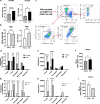Role for BLT1 in regulating inflammation within adipose tissue immune cells of aged mice
- PMID: 39187841
- PMCID: PMC11346001
- DOI: 10.1186/s12979-024-00461-0
Role for BLT1 in regulating inflammation within adipose tissue immune cells of aged mice
Abstract
Background: Aging is a complex biological process characterized by obesity and immunosenescence throughout the organism. Immunosenescence involves a decline in immune function and the increase in chronic-low grade inflammation, called inflammaging. Adipose tissue expansion, particularly that of visceral adipose tissue (VAT), is associated with an increase in pro-inflammatory macrophages that play an important role in modulating immune responses and producing inflammatory cytokines. The leukotriene B4 receptor 1 (BLT1) is a regulator of obesity-induced inflammation. Its ligand, LTB4, acts as a chemoattractant for immune cells and induces inflammation. Studies have shown that BLT1 is crucial for cytokine production during lipopolysaccharide (LPS) endotoxemia challenge in younger organisms. However, the expression patterns and function of BLT1 in older organisms remains unknown.
Results: In this study, we investigated BLT1 expression in immune cell subsets within the VAT of aged male and female mice. Moreover, we examined how antagonizing BLT1 signaling could alter the inflammatory response to LPS in aged mice. Our results demonstrate that aged mice exhibit increased adiposity and inflammation, characterized by elevated frequencies of B and T cells, along with pro-inflammatory macrophages in VAT. BLT1 expression is the highest in VAT macrophages. LPS and LTB4 treatment result in increased BLT1 in young and aged bone marrow-derived macrophages (BMDMs). However, LTB4 treatment resulted in amplified Il6 from aged, but not young BMDMs. Treatment of aged mice with the BLT1 antagonist, U75302, followed by LPS-induced endotoxemia resulted in an increase in anti-inflammatory macrophages, reduced phosphorylated NFκB and reduced Il6.
Conclusions: This study provides valuable insights into the age- and sex- specific changes in BLT1 expression on immune cell subsets within VAT. This study offers support for the potential of BLT1 in modulating inflammation in aging.
Keywords: Aging; Inflammation; Leukotriene B4 receptor 1 (BLT1); Macrophage; Sepsis; Visceral adipose tissue.
© 2024. The Author(s).
Conflict of interest statement
The authors declare no competing interests.
Figures





Similar articles
-
Inhibition of leukotriene B4 receptor 1 attenuates lipopolysaccharide-induced cardiac dysfunction: role of AMPK-regulated mitochondrial function.Sci Rep. 2017 Mar 14;7:44352. doi: 10.1038/srep44352. Sci Rep. 2017. PMID: 28290498 Free PMC article.
-
Macrophage LTB4 drives efficient phagocytosis of Borrelia burgdorferi via BLT1 or BLT2.J Lipid Res. 2017 Mar;58(3):494-503. doi: 10.1194/jlr.M068882. Epub 2017 Jan 4. J Lipid Res. 2017. PMID: 28053185 Free PMC article.
-
Therapeutic potential of BLT1 antagonist for COPD: involvement of inducing autophagy and ameliorating inflammation.Drug Des Devel Ther. 2019 Sep 4;13:3105-3116. doi: 10.2147/DDDT.S215433. eCollection 2019. Drug Des Devel Ther. 2019. PMID: 31564828 Free PMC article.
-
Recent advances in function and structure of two leukotriene B4 receptors: BLT1 and BLT2.Biochem Pharmacol. 2022 Sep;203:115178. doi: 10.1016/j.bcp.2022.115178. Epub 2022 Jul 16. Biochem Pharmacol. 2022. PMID: 35850310 Review.
-
The role of the LTB4-BLT1 axis in health and disease.Pharmacol Res. 2020 Aug;158:104857. doi: 10.1016/j.phrs.2020.104857. Epub 2020 May 18. Pharmacol Res. 2020. PMID: 32439596 Review.
Cited by
-
Distinct immunomodulation elicited by young versus aged extracellular vesicles in bone marrow-derived macrophages.Immun Ageing. 2024 Oct 21;21(1):72. doi: 10.1186/s12979-024-00472-x. Immun Ageing. 2024. PMID: 39434100 Free PMC article.
-
Adipose tissue aging as a risk factor for metabolic organ abnormalities: mechanistic insights and the role of exercise interventions.Lipids Health Dis. 2025 Sep 2;24(1):274. doi: 10.1186/s12944-025-02695-3. Lipids Health Dis. 2025. PMID: 40898292 Free PMC article. Review.
References
Grants and funding
LinkOut - more resources
Full Text Sources

